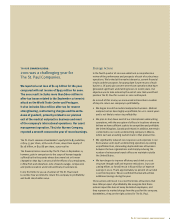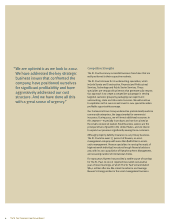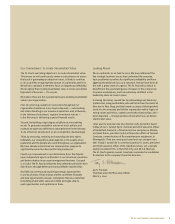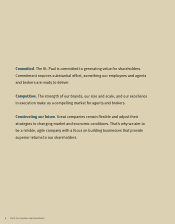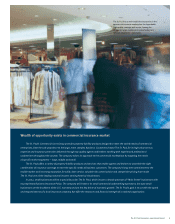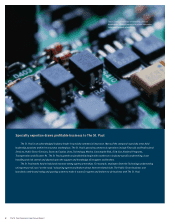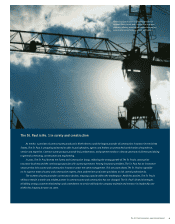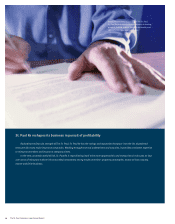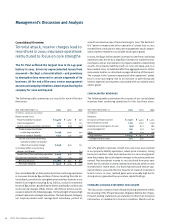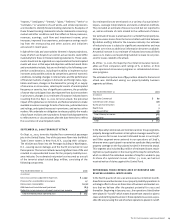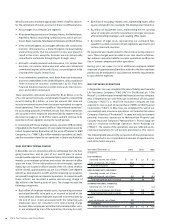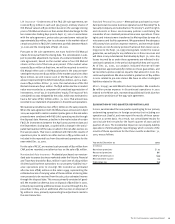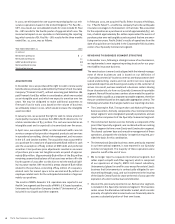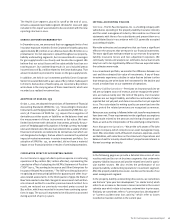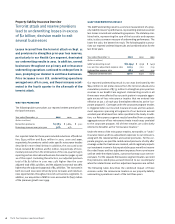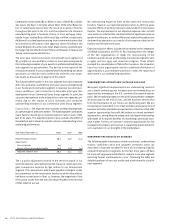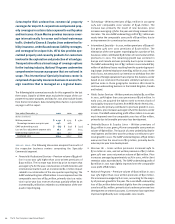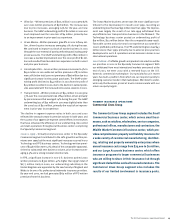Travelers 2001 Annual Report Download - page 15
Download and view the complete annual report
Please find page 15 of the 2001 Travelers annual report below. You can navigate through the pages in the report by either clicking on the pages listed below, or by using the keyword search tool below to find specific information within the annual report.
“expects,” “anticipates,” “intends,” “plans,” “believes,” “seeks” or
“estimates,” or variations of such words, and similar expressions
are intended to identify forward-looking statements. Examples of
these forward-looking statements include statements concerning:
market and other conditions and their effect on future premiums,
revenues, earnings, cash flow and investment income; price
increases, improved loss experience, and expense savings result-
ing from the restructuring and other actions and initiatives
announced in recent years.
In light of the risks and uncertainties inherent in future projections,
many of which are beyond our control, actual results could differ
materially from those in forward-looking statements. These state-
ments should not be regarded as a representation that anticipated
events will occur or that expected objectives will be achieved. Risks
and uncertainties include, but are not limited to, the following: com-
petitive considerations, including the ability to implement price
increases and possible actions by competitors; general economic
conditions, including changes in interest rates and the performance
of financial markets; changes in domestic and foreign laws, regu-
lations and taxes; changes in the demand for, pricing of, or supply
of insurance or reinsurance; catastrophic events of unanticipated
frequency or severity; loss of significant customers; the possibility
of worse-than-anticipated loss development from business written
in prior years; changes in our estimate of insurance industry losses
resulting from the Sept. 11, 2001 terrorist attack; the potential
impact of the global war on terrorism and Federal solutions to make
available insurance coverage for acts of terrorism; judicial decisions
and rulings; anticipated increases in premiums; and various other
matters. We undertake no obligation to release publicly the results
of any future revisions we may make to forward-looking statements
to reflect events or circumstances after the date hereof or to reflect
the occurrence of unanticipated events.
september 11, 2001 terrorist attack
On Sept. 11, 2001, terrorists hijacked four commercial passenger
jets in the United States. Two of the jets were flown into the World
Trade Center towers in New York, N.Y., causing their collapse.
The third jet was flown into the Pentagon building in Washington,
D.C., causing severe damage, and the fourth jet crashed in rural
Pennsylvania. This terrorist attack caused significant loss of life and
resulted in unprecedented losses for the property-liability insur-
ance industry. Our estimated net pretax loss incurred as a result
of the terrorist attack totaled $941 million, consisting of the
following components.
Year ended December 31 2001
(In millions)
Gross loss and loss adjustment expenses $2,299
Provision for uncollectible reinsurance 47
Reinsurance recoverables (1,231)
Additional and reinstatement premiums (83)
Reduction in reinsurance contingent commission expense (91)
Total estimated pretax operating loss $ 941
Our estimated losses were based on a variety of actuarial tech-
niques, coverage interpretations and claims estimation methods.
They included an estimate of losses incurred but not reported to
us, and an estimate of costs related to the settlement of claims.
Our estimate of losses is also based on our belief that property-lia-
bility insurance losses from the terrorist attack will total between
$30 billion and $35 billion for the insurance industry. Our estimate
of industry losses is subject to significant uncertainties and may
change over time as additional information becomes available.
A material increase in our estimate of industry losses would likely
cause us to make a corresponding material increase to our provi-
sion for losses related to the attack.
As of Dec. 31, 2001, the majority of our total reinsurance recover-
ables are from companies with ratings of A- or better, or from
state-sponsored reinsurance programs or collateralized reinsur-
ance programs.
The estimated net pretax loss of $941 million related to the terrorist
attack was distributed among our property-liability business
segments as follows.
Year ended December 31 2001
(In millions)
Specialty Commercial $ 89
Commercial Lines Group 108
Surety and Construction 2
Health Care 5
Lloyd’s and Other 181
Total Primary Insurance 385
Reinsurance 556
Total $ 941
In the Specialty Commercial and Commercial Lines Group segments,
property damage and business interruption coverages were the pri-
mary sources for losses incurred. Estimated losses in our Lloyd’s
and Other segment were centered in our operations at Lloyd’s,
where we were a participant in an aviation syndicate that provided
property coverage on the four planes involved in the terrorist attack.
This segment also included $50 million of estimated losses result-
ing from our participation in the insuring of the Lloyd’s Central Fund,
which is utilized if an individual member of Lloyd’s is unable to pay
its share of a syndicate’s losses. At Dec. 31, 2001, we had not
received notice of claims against the Central Fund.
withdrawal from certain lines of business and
related goodwill write-down
In the fourth quarter of 2001, we announced our intention to with-
draw from several businesses in our property-liability operations in
a strategic effort to focus on those lines of business and market sec-
tors that we believe offer the greatest potential for 2002 and
thereafter. Beginning in January 2002, the operations listed below
were placed in “runoff,” which means that we have ceased or plan to
cease underwriting new business in these operations as soon as pos-
sible. We are pursuing the sale of certain operations placed in runoff.
The St. Paul Companies 2001 Annual Report 13


